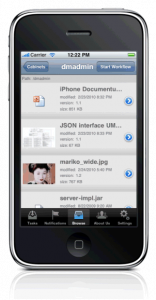Media Work Space
Controlled release in June 30th targetted at internal use at EMC Marketing, General Availability will come later this year. Still licensed with DAM. The new release will support Images, Presentation, Audio and video.
It will introduce a new gridless view which lists all objects as list with columns for attributs. Gridless view also can can show thumbnails at the left end of each line. There will also be a storyboard view much like the one existing in today’s Digital Asset Manager.
MWS will now have support for comments – which can interact with CenterStage comments.
Personalised Dashboard include the following views:
- QuickFlows
- Most Popular Assets
- Recently Viewed Assets
- Recently Updated Assets
To met that looks like they have starting to think in terms of Information Analytics…There is now also a feature to show the accumulative rating among users.
They see a need for customisations and an SDK or similar will be released during 2009
The Inbox allows to open a quickflow which actually was really nice-looking with attached images as thumbnails below. Looked rather similar to an email message which is the right way to go I think.
QuickSearch now supports searching on any index data.
Advanced Search has a tab called General and then for Presenation, Video, Audio and Images which allows for a higher level restriction of search.
Search on properties for instances image with a certain pixels…
There is new Presentation slide view which looks way more flexible than current PowerPoint assembly. Looks actually like viewing/reviewing slides now can be done completely without opening the application.
The view below the preview of the slides has tabs for Metadata, Versions, Rendtions, Comments, Permission Relationships
Slides can be rated and metadata can be editied just by clicking in the fields.
Video view supports thumbnails but also preview of the video utilzing FlipFactory. Looked like the previewer was using Flash.
FileSharing Services, My Documentum and Documentum for Outlook will be merged into a new MyDocumentum product and then moved into the Knowledge Worker group. Documentum Connector for InDesign & Quark Xpress are also part of My Documentum but from a Digital Asset Management side of the house.
Many companies have 3D-data which comes from different CA-systems. Therefore they have started to develop CAD Integration with in Documentum with support of Right Hemisphere Integration (press release) which supports viewing data from 80 CAD/PLM-systems.
The solutions allows customers to request and repurpose derivatives
Flat Iron Solutions have a demonstration in the exhibition area at EMC World 2009.
Content Transformation Services
There are mainly bug fixes and some Improvements on the performance for the OEM products they are using mainly on the image side of the house.
CTS now includes support for for Adobe CS3 & CS4
There is an SDK for CTS which can be used to handle custom encoders….from my point of view the obvious question is whether or not i make sense to develop support for GIS-formats?
The next release of MWS will probably be available in September 2009.
There is available technology in the the platform to support annotations on video files but not yet exposed.
Aility to show forms in a Flex environment is something they are working on and it seems fairly important especially for us who use both TaskSpace and DAM with Forms.
VISION
The main areas which they focus on are:
Web Experience Management
Customer Comms Management (build websites based on preferences)
Customer Intelligence Management
Marketing Process Management
Brand Management include:
– Presentation
– Video
– Image
– Collateral
– 3D Image
– Agency Collaboration
MidYear
– New version of Presentation Assembly
End of Year
– MWS Pro
– Integrated Collaboration and Publsihing
– Campaign Management
– Marketiing and Web Metrics Tracking
– KPI
– Rapid and Setup of Brand
D7 – 2010
– MWS Field Editin
– SalesForce integration
– Support of Personalised Customer
MWS Pro
– Different Libraries as Tabs
Q1 2010 MWS & DAM Sp3
